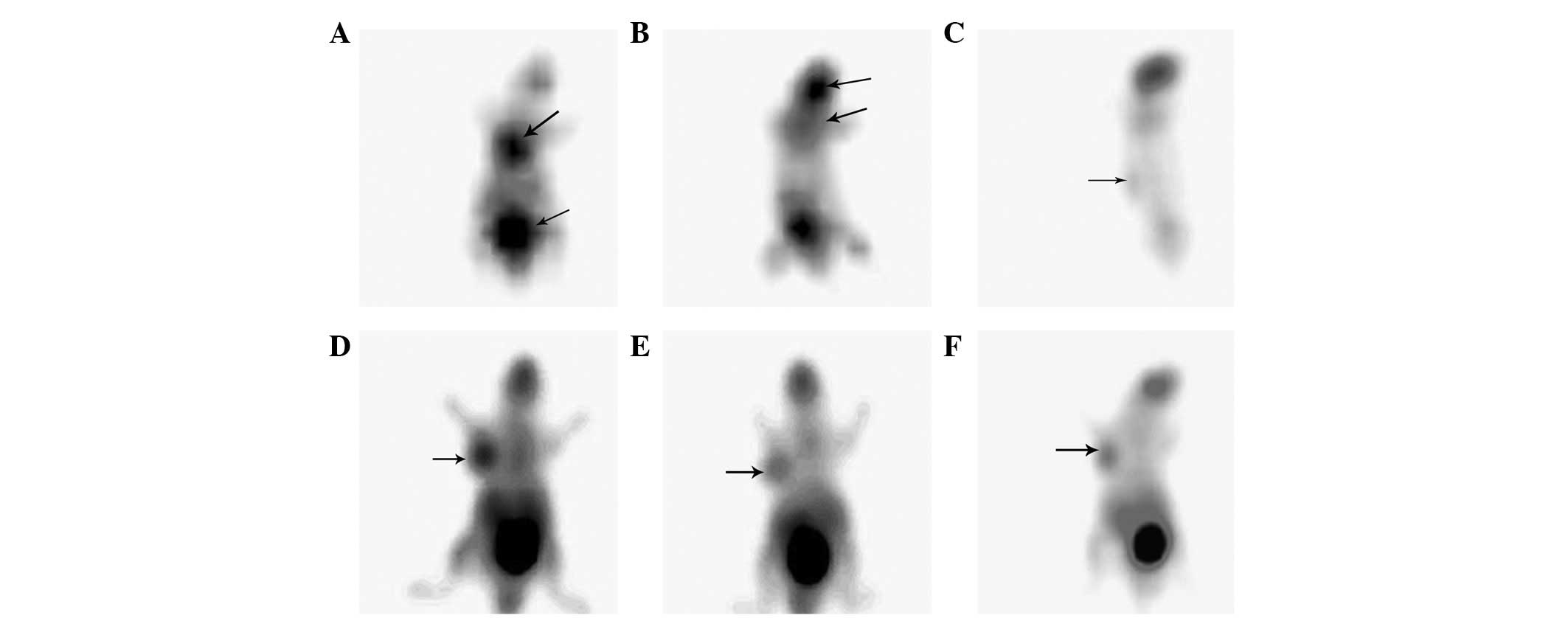|
1
|
Jemal A, Siegel R, Ward E, Murray T, Xu J,
Smigal C and Thun MJ: Cancer statistics, 2006. CA Cancer J Clin.
56:106–130. 2006. View Article : Google Scholar
|
|
2
|
Siegel R, Naishadham D and Jemal A: Cancer
statistics, 2012. CA Cancer J Clin. 62:10–29. 2012. View Article : Google Scholar
|
|
3
|
Kyzas PA, Evangelou E and Denaxa-Kyza D:
18F-fluorodeoxyglucose positron emission tomography to
evaluate cervical node metastases in patients with head and neck
squamous cell carcinoma: a meta-analysis. J Natl Cancer Inst.
100:712–720. 2008. View Article : Google Scholar : PubMed/NCBI
|
|
4
|
Gambhir SS, Czernin J, Schwimmer J,
Silverman DH, Coleman RE and Phelps ME: A tabulated summary of the
FDG PET literature. J Nucl Med. 42(Suppl): 1S–93S. 2001.PubMed/NCBI
|
|
5
|
Abbey CK, Borowsky AD, McGoldrick ET,
Gregg JP, Maglione JE, Cardiff RD and Cherry SR: In vivo
positron-emission tomography imaging of progression and
transformation in a mouse model of mammary neoplasia. Proc Natl
Acad Sci USA. 101:11438–11443. 2004. View Article : Google Scholar : PubMed/NCBI
|
|
6
|
Dearling JL, Flynn AA, Sutcliffe-Goulden
J, Petrie IA, Boden R, Green AJ, Boxer GM, Begent RH and Pedley RB:
Analysis of the regional uptake of radiolabeled deoxyglucose
analogs in human tumor xenografts. J Nucl Med. 45:101–107.
2004.PubMed/NCBI
|
|
7
|
Waldherr C, Mellinghoff IK, Tran C,
Halpern BS, Rozengurt N, Safaei A, Weber WA, Stout D, Satyamurthy
N, Barrio J, Phelps ME, Silverman DH, Sawyers CL and Czernin J:
Monitoring antiproliferative responses to kinase inhibitor therapy
in mice with 3′-deoxy-3′-18F-fluorothymidine PET. J Nucl
Med. 46:114–120. 2005.PubMed/NCBI
|
|
8
|
Hatt M, Cheze-le Rest C, van Baardwijk A,
Lambin P, Pradier O and Visvikis D: Impact of tumor size and tracer
uptake heterogeneity in 18F-FDG PET and CT non-small
cell lung cancer tumor delineation. J Nucl Med. 52:1690–1697. 2011.
View Article : Google Scholar : PubMed/NCBI
|
|
9
|
Wu SH and Yu CJ: The establishment of
nasopharyngeal carcinoma (NPC) animal model and observation of
biologic characteristics from NPC. Journal of Qiqihar Medical
College. 28:2183–2184. 21872007.(In Chinese).
|
|
10
|
Yuan JW, Feng YL, Xian WJ, Fan LX, He XH,
Yuan BH, Huang KM, Su SD and Liu Y: Application of clinical PET-CT
scanner for human nasopharyngeal carcinoma (NPC) transplantation
tumor animal model in nude mice. Anatomy Research. 31:378–381.
2009.
|
|
11
|
Fueger BJ, Czernin J, Hildebrandt I, Tran
C, Halpern BS, Stout D, Phelps ME and Weber WA: Impact of animal
handling on the results of 18F-FDG PET studies in mice.
J Nucl Med. 47:999–1006. 2006.PubMed/NCBI
|
|
12
|
Mossberg KA and Taegtmeyer H: Time course
of skeletal muscle glucose uptake during euglycemic
hyperinsulinemia in the anesthetized rabbit: a
fluorine-18–2-deoxy-2-fluoro-D-glucose study. J Nucl Med.
33:1523–1529. 1992.PubMed/NCBI
|
|
13
|
Huitink JM, Visser FC, van Leeuwen GR, van
Lingen A, Bax JJ, Heine RJ, Teule GJ and Visser CA: Influence of
high and low plasma insulin levels on the uptake of fluorine-18
fluorodeoxyglucose in myocardium and femoral muscle, assessed by
planar imaging. Eur J Nucl Med. 22:1141–1148. 1995. View Article : Google Scholar : PubMed/NCBI
|
|
14
|
Himms-Hagen J: Thermogenesis in brown
adipose tissue as an energy buffer: implications for obesity. N
Engl J Med. 311:1549–1558. 1984. View Article : Google Scholar : PubMed/NCBI
|
|
15
|
Gordon C: Temperature Regulation in
Laboratory Rodents. New York, NY: Cambridge University Press; 1993,
View Article : Google Scholar
|
|
16
|
Leon LR, Blaha MD and DuBose DA: Time
course of cytokine, corticosterone, and tissue injury responses in
mice during heat strain recovery. J Appl Physiol. 100:1400–1409.
2006. View Article : Google Scholar : PubMed/NCBI
|
|
17
|
Zhuang H, Pourdehnad M, Lambright ES,
Yamamoto AJ, Lanuti M, Li P, Mozley PD, Rossman MD, Albelda SM and
Alavi A: Dual time point 18F-FDG PET imaging for
differentiating malignant from inflammatory processes. J NuclMed.
42:1412–1417. 2001.PubMed/NCBI
|
|
18
|
Abe Y, Tamura K, Sakata I, Ishida J, Ozeki
Y, Tamura A, Uematsu K, Sakai H, Goya T, Kanazawa M and Machida K:
Clinical implications of 18F-fluorodeoxyglucose positron
emission tomography/computed tomography at delayed phase for
diagnosis and prognosis of malignant pleural mesothelioma. Oncol
Rep. 27:333–338. 2012.
|










